Alfred Hitchcock's MacGuffins
WARNING:
There are lots of spoilers here
|
Film Title
(chronological order)
|
Identification of MacGuffin(s)
|
Screenshots of MacGuffin(s)
|
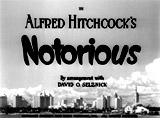
Notorious (1946)
|
- the first MacGuffin: the importance of the key to
the mansion's wine cellar - only one key existed, and it was in
the possession of Nazi sympathizer Alexander Sebastian (Claude
Rains) in Brazil; Alex's
wife Alicia Huberman (Ingrid Bergman) took the wine cellar key
off Alex's key ring and passed it to Devlin (Cary Grant)
- the second main MacGuffin: radioactive
material (uranium ore or "vintage
sand") found in a locked cellar's wine bottles that was being
smuggled; it was discovered when one bottle smashed onto the floor
and revealed uranium powder being mined in the mountains of Brazil
by the Nazis
- another very secondary MacGuffin was the poison
in the coffee used to slowly kill Alicia
|
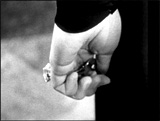
The Key to the Wine Cellar Hidden in Alicia's Hand

The Key Slipped to Devlin
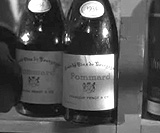
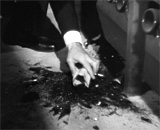
Uranium Sand Discovered Hidden in Wine Bottles
|
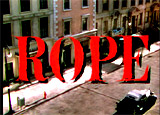
Rope (1948)
|
- the MacGuffin: the whereabouts of David Kentley
(Dick Hogan), continually the main item of discussion in the film
by guests at a dinner party
- (David's corpse had been stuffed into an old
wooden chest in the middle of the room - that was to be used as
a buffet table!)
- tension was created because the body might
be discovered at any moment by the guests
- another MacGuffin: the rope - out in the open -
used for the strangulation murder of David, and then dangled about
and used to tie up a bundle of books
- a secondary MacGuffin: the wrong hat (the victim's
monogrammed hat) picked up by Rupert (James Stewart)
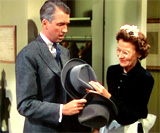
The Mix-Up in Hats
|
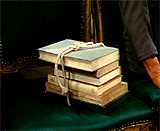
The Rope Used to Tie Books Together
|

The Murder Weapon Used to Strangle David
|
|
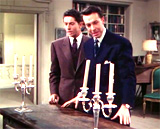

The Chest Holding the Body - Chosen as The Dinner Party's
Buffet Table
|
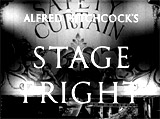
Stage Fright (1950)
|
- the MacGuffin: the blood-stained dress - allegedly
worn by stage actress/singer Charlotte Inwood (Marlene Dietrich)
when she murdered her husband
- Charlotte's secret lover was another actor named
Jonathan Cooper (Richard Todd); in a flashback (although later
learned to be untrue), he claimed that Charlotte came to his apartment
door wearing the blood-stained dress to confess
to the murder of her "abominable" husband during a quarrel
in their bedroom; in his account, he described how he offered to
go back to her London house to get her a clean replacement dress,
and also arrange the murder scene to make it look as if there had
been a bungled robbery; however, he had to flee when Charlotte's
lower-class maid Nellie Goode (Kay Walsh) screamed when she saw
the body, and watched him as he fled down the stairs
- Jonathan became
the prime suspect - but had he been framed by Charlotte, or was he
really involved? - as Jonathan evaded police, an investigation
commenced, and at times, it appeared likely that Charlotte was
the guilty one
- by the conclusion, it was revealed that Charlotte
had conspired to kill her husband, but it was Jonathan who had
committed the deed (although Charlotte was present); he admitted
that his earlier 'flashback' story was mostly a lie - he was the
one who had smeared blood onto the dress, and had killed her husband
out of jealousy when Charlotte ended her relationship with him,
and was preparing to marry her manager Freddie
Williams (Hector MacGregor)
|

The Bloody-Dress
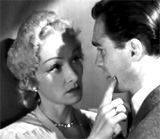
Jonathan with Charlotte
|
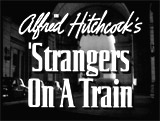
Strangers on a Train (1951)
|
- the MacGuffin: Guy Haines' (Farley Granger)
cigarette lighter, monogrammed with "A to G" and
with a symbol of two criss-crossed tennis rackets -- it was a gift
from Guy's girlfriend Anne Morton (Ruth Roman) to him
- the lighter was to be used as incriminating evidence,
to be planted by villainous psychotic Bruno Antony (Robert Walker)
in order to frame Guy for murder
- in the conclusion, as Bruno died from being crushed
under a carousel, he refused to clear Guy, but his hand opened
- revealing Guy's lighter (and innocence)
|
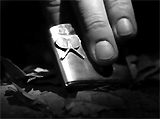
Guy's Cigarette Lighter

Guy's Lighter Revealed in Bruno's Opening Dead Hand
|
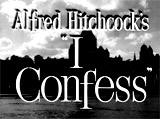
I Confess (1953)
|
- the MacGuffin: the privileged
or confidential information wanted by the police - a Catholic confession
- the information was contained in an admission-confession
given by sexton Otto Keller
(O.E. Hasse), a German immigrant and housekeeper; he made the confession
(of an accidental murder of crooked lawyer
Vilette (Ovila Légaré)), to his
Catholic priest Father Michael Logan (Montgomery Clift) in Quebec
City
|

Confessional Given by Otto Keller to His Priest Father
Logan
|

Dial M for Murder (1954)
|
- the MacGuffin: the duplicate latch-keys to the Wendice
apartment - especially the one hidden under the stair carpet outside the
apartment - the one that incriminated Tony Wendice (Ray Milland)
in the final scene when he let himself in with the stair's key
- revealing that he had designed the murder plot against his wife
- the key under the stair's carpet was his wife Margot’s
(Grace Kelly) own duplicate house key, which Tony snuck out of
her handbag and put under the stairway carpet outside their door
- it was put there to let wife-murderer Capt. Lesgate/Swann (Anthony
Dawson) into the apartment, in a plot with Tony
- during the murder,
Lesgate was specifically instructed to enter with the key, commit
the murder, then exit out the way he came, lock the door, and replace
the key under the stairs - however, after opening the door, Swann
returned the key to its hiding place immediately
- during the investigation after the botched murder,
Tony made an incorrect assumption - he postulated inaccurately that
Swann must still have Margot's latch-key (from the stairs) on him
in his pocket; so he surreptitiously took the key from Swann's
pocket (Swann's own apartment key) and placed it back in Margot's
purse; this mistake would ultimately lead to a self-incriminating
display of his own guilt
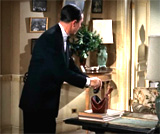
After the Botched Murder, Tony Placed Swann's Key
Back Into Margot's Purse
|
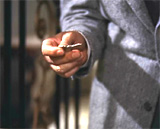
The Latch-Key From Stairway Used to Open Door in
Film's Concluding Scene
|
|
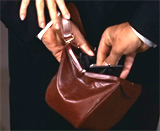
Tony Sneaking Margot's Housekey Out of Her Handbag
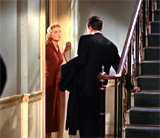
Tony Positioning Margot's Key On Stairway for Swann to Use For Entry
|
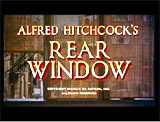
Rear
Window (1954)
|
- the MacGuffin: the suspected 'murder' committed
by apartment tenant and traveling salesman Lars Thorwald (Raymond
Burr) across the courtyard, of his bed-ridden wife Mrs. Emma Thorwald
(Irene Winston), and the suspicion about what was buried in the
courtyard's garden?
- the lingering question: what happened to her?
- there was circumstantial evidence that was slowly
pieced together:
- (a saw and butcher knife wrapped in newspaper
- the moving of a heavy trunk
- the removal of
jewelry from the wife's handbag
- a strangled dog that had snooped
in the courtyard's garden, etc.
|
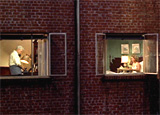
Mr. and Mrs. Thorwald
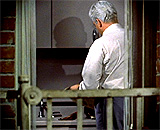
Mr. Thorwald's Suspicious Packing
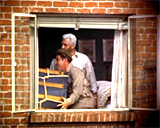
Trunk Carried Out
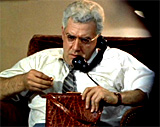
Taking Jewelry From Wife's Left-Behind Handbag
|

To Catch a Thief (1955)
|
- the MacGuffin: the identity of the cat-burglar
who committed a daring, night-time burglary (jewel theft) in
the opening sequence set on the Riviera - the perpetrator was
suspected to be reformed burglar John Robie (Cary Grant) (nicknamed "The
Cat")
- in the film's conclusion during a costume ball,
Robie finally proved he was innocent and caught the real masked copycat
thief - young blonde Danielle Foussard (Brigitte Auber), who was
dangled from the roof until she confessed that her father Foussard
(Jean Martinelli) and restauranteur Bertani (Charles Vanel) had
planned all of the robberies [Note: Danielle was the daughter of
the head waiter at Bertani's restaurant]
|
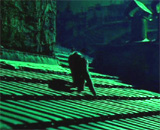
Who was the Figure in Black - a Cat Burglar?

Cat Burglar Revealed
|
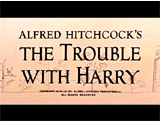
The Trouble With Harry (1955)
|
- the MacGuffin: Harry's corpse, found on a hill
in the Highwater, Vermont forested countryside
- there were many diversionary elements to the murder
mystery plot and its MacGuffin - the frantic search of townsfolk
(some of whom believed they were guilty) to learn:
- WHAT or WHO killed the victim (early on identified as Harry Worp from Boston, played by Philip Truex)
- HOW did the victim die
- WHAT were the victim's interactions with some of the villagers that
caused them to think they had killed him
- the story's plot told more about its characters and
their relationships than about the central (and titular) dead man
- a perfect MacGuffin
- the main dilemma (a story of cover-up) turned out
to be: WHAT TO DO WITH THE BODY (that was buried and exhumed several
times to avoid police charges) - especially to conceal it from being
discovered by dim-witted Deputy Sheriff Calvin Wiggs (Royal Dano)
- in the conclusion, the town's befuddled Dr. Greenbow
(Dwight Marfield) announced that Harry died of natural causes - presumably
a heart attack, although the corpse had a nasty bullet-like wound
on his forehead, and Jennifer Rogers (Shirley MacLaine) admitted
that at her doorstep that morning, she had whacked Harry (her second
ex-husband who abandoned her) with a milk bottle in the head (he
presumably staggered up into the woods and died)
- the film opened with retired seaman Captain Albert
Wiles (Edmund Gwenn) hunting rabbits in the woods and fearing
that his third bullet had struck Harry and killed him - although
later on, he learned that his third shot had actually killed a rabbit
- another village
resident, spinster Miss Ivy Graveley (Mildred Natwick) suspected
that she had killed Harry when he attacked her on the hillside and
she struck him in the forehead with the leather heel (and metal cleat)
of her sturdy hiking shoes
|
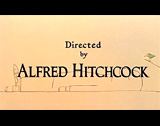
Opening Credits: Sketch of Harry's Body

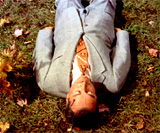
First Views of Harry
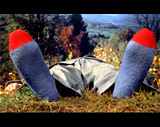
The Lifeless Corpse - Viewed at Ground Level (After
His Shoes Were Stolen by a Tramp)
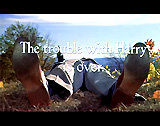
Last Frame of Film
|

The Man Who Knew Too Much (1956)
|
- the MacGuffin: it was the warning (a whispered
message from a dying man) that there was to be an assassination
of a foreign statesman in London - and that the authorities must know
about "Ambrose Chappell"
- in the plot, the McKenna family, Dr. Ben McKenna (James
Stewart) and his famous singer-wife Jo Conway McKenna (Doris Day),
while in Marrakesh, French Morocco, became acquainted with French
businessman Louis Bernard (Daniel Gelin); the next day in the town
square during an acrobatic show, a dark-skinned man lethally wounded
in the back with a knife stumbled into Ben's arms and whispered: "A
man, a statesman is to be killed...assassinated...in London, soon,
very soon. Tell them in London to try...Ambrose Chappell"; the
man was Louis Bernard in disguise; Ben transcribed the man's words,
later given on a note to Jo; it was revealed that
Bernard was a known agent of the Deuxieme Bureau (the French version
of the FBI)
- after their young son Hank McKenna (Christopher Olsen)
was kidnapped, the couple returned to London where Ben received anonymous
phone calls and was pressured to keep silent; nonetheless, Ben
went on a search for a person named 'Ambrose Chappell'
- it was Jo who
understood that 'Ambrose Chappell' was an actual place, Ambrose Chapel,
where she and Ben found further clues to the assassination plot
- the film climaxed during a performance at the Royal
Albert Hall where the assassination attempt of the foreign prime
minister was thwarted
|
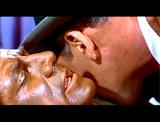
Dying Louis Bernard's Misinterpreted Whispered Words
About Assassination Plot
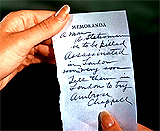
Assassination Attempt Written in Note
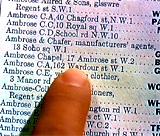
Ambrose Chapel - a Place in the Phone Book, not a Personal Name
|
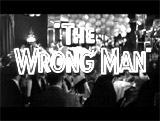
The Wrong Man (1956)
|
- the MacGuffin: would Stork Club musician
'Manny' Balestrero (Henry Fonda) ever be cleared of the crime (assault
and robbery) he allegedly committed?
- Christopher Emanuel “Manny” Balestrero
was arrested on suspicion of robbery of an insurance company, and
due to circumstantial evidence (a spelling mistake, and his similar
appearance to the actual criminal) was arrested and booked - he
was only released after the real crook was apprehended for robbing
a delicatessan and clearly was 'Manny's' double in a case of mistaken-identity
|
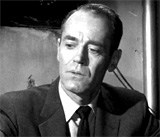
Wrongly-Accused Manny Balestrero (Henry Fonda)
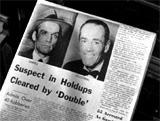
The Two Identical-Looking Suspects
|
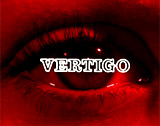
Vertigo
(1958)
|
- the MacGuffin: the spirit of a dead woman known
as Carlotta Valdes, motivating obsessed Scottie Ferguson (James
Stewart) to investigate what possessed or haunted his beloved but
now-dead Madeleine Elster (Kim Novak), Carlotta's great-granddaughter
- a suspicious link between Carlotta
and Judy was established when Judy (who was dressed to look like
Madeleine at Scottie's insistence) decided to wear Carlotta's red-ruby
heirloom necklace (it revealed that Judy was involved in the on-going
deception of pretending to be Madeleine, who actually didn't exist)
- two secondary MacGuffins: Madeleine herself (non-existent),
and Scottie's crippling fear of heights and vertigo
|

Carlotta Valdes - With Necklace
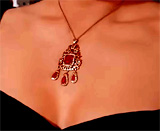
Judy Linking Herself to Carlotta (and Madeleine) by Wearing Her Necklace
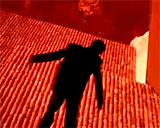
Scottie's Nightmarish Fear of Heights
|

North by Northwest (1959)
|
- the MacGuffin: the existence
of CIA agent "George Kaplan" (mistakenly
thought to be Cary Grant's character Roger Thornhill) who was being
chased by spies, but 'George Kaplan' didn't really exist
- another MacGuffin: "government
secrets" on microfilm - the microfilm was hidden in a
Pre-Columbian statue of a warrior that was being smuggled out of
the country by the spies, led by Philip Vandamm (James Mason)
- the true definition of a MacGuffin - it was revealed
to be the central nature of Roger O. Thornhill's identity, based
upon his own initials: R-O-T - with the middle initial implying "nothing"
|

Roger Thornhill (Cary Grant) Seized and Identified as
the Non-Existent "George Kaplan"

Roger's R.O.T. Initials

Statue with Microfilm
|

Psycho
(1960)
|
- the original MacGuffin: $40,000 of stolen money
(in an envelope), taken from the realtors' Phoenix office by employee
Marion Crane (Janet Leigh), who intended to run off with her debt-ridden
lover Sam Loomis (John Gavin)
- at the Bates Motel run by nervous, suspicious and
creepy proprietor Norman Bates (Anthony Perkins), Marion had second
thoughts and regrets about the theft and was planning on returning
the $40,000 the next day
- the money was ultimately wrapped up in a newspaper
in the motel bedroom - discarded, and sunk in the trunk of the
murdered Marion's car into a swamp, by Norman, to allegedly cover
up for the stabbing shower murder of Marion by a female figure
(his mother?) wielding a knife
- two new MacGuffins then surfaced - (a) the whereabouts
of Marion Crane?, and (b) the apparent existence of Norman's
invalid, bed-ridden mother who lived in the house perched on
the hill behind the hotel - she might be able to help in the
search for the whereabouts of Marion
- and then
came a second brutal murder; Detective Milton Arbogast (Martin
Balsam) was assaulted at the top of the stairs - again by the knife-wielding,
dress-wearing figure; was Norman's mother (Mrs. Bates) responsible
for both murders?
- the entire plot was upturned when the town's Sheriff
Chambers (John McIntire) described how Mrs. Bates had died over
ten years earlier in a double-murder suicide: ("Well, if the woman
up there is Mrs. Bates, who's that woman buried out in Greenlawn
Cemetery?")
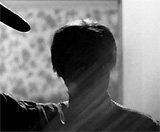
The "Mother" Figure Involved in Shower-Stabbing Death
of Marion
|

The Shadow of "Mother' in The Window of the
Bates Motel's House
|
|

$40,000 in envelope on Marion's Bed
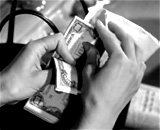
Marion Counting the Money

The Money Wrapped in LA Newspaper in Bates Motel Room
|
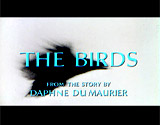
The Birds (1963)
|
- the main MacGuffin: the unexplained cause, explanation
or reason for the strange bird attacks in the town of Bodega Bay
- hypothesized by many in the Tides Restaurant attack sequence;
however, ultimately, there was no solid, rational reason why the
birds were attacking - they were not seeking revenge for nature's
mistreatment, or foreshadowing doomsday, and they didn't represent
God's punishment for humankind's evil
- one of the more insightful reasons given was an
hysterical mother's (Doreen Lang) vicious attack on rich and
glamorous socialite Melanie Daniels (Tippi Hedren) for bringing
some kind of chaotic "evil" into town: "Why are they doing this?
Why are they doing this? They said when you got here, the whole
thing started. Who are you? What are you? Where did you come from?
I think you're the cause of all this. I think you're evil. (Shrieking)
EVIL!"
- earlier in the film, it
was noted that Melanie was known for destructive and expensive
practical jokes that often back-fired on her ("Don't you remember
one of your practical jokes that resulted in the smashing of a
plate-glass window?"), and later, Melanie's notorious reputation
as a jet-setting rich socialite was recollected in another scandalous
report about her cavorting naked (as a jaybird?) into a fountain
(birdbath?) in Rome the previous summer
- the underlying MacGuffin: the nature of the conflicted
romance between Melanie Daniels and Mitch Brenner (Rod Taylor)
- symbolized by a gift of two love-birds; the attacks were mysteriously
related to the mother and son relationship in the film - Mitch's
jealous, initially hostile mother Lydia Brenner (Jessica Tandy)
expressed anger (and fears of abandonment or being left lonely)
that came to the surface when her bachelor son Mitch brought
home the attractive young Melanie
- it was clear that the "birds" (females) in the film,
including Lydia, Melanie, and the town's schoolteacher Annie Hayworth
(Suzanne Pleshette) (Mitch's former girlfriend) were circling and
flocking around, seeking attention and affection from the sole,
emotionally-cold male lead
|

Melanie and Mitch - Symbolized by Lovebirds
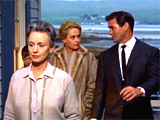
Lydia, Melanie, and Mitch
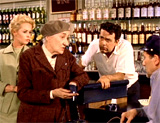
Reasons Suggested for Bird Attacks by Ornithologist Expert
Mrs. Bundy (Ethel Griffies)
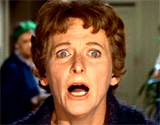
Hysterical Mother's Accusation Against the "Evil" Melanie
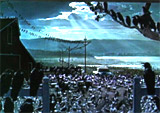
The Birds' Takeover of Bodega Bay
|
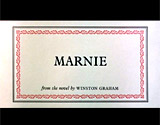
Marnie (1964)
|
- the MacGuffin: thunderstorms and the color red that
triggered or caused deep-rooted psychological problems and neuroses
for Marnie, but why?
- it was eventually explained that Marnie experienced
extreme childhood trauma - seen in flashback - that occurred during
the murder of her mother's abusive sex partner, drawing red blood
- the revelation of the root of Marnie's problems
occurred in the Baltimore home of her crippled mother Bernice Edgar
(Louise Latham) during a thunderstorm; she remembered (and relived)
how her prostitute-mother's leg was broken by a Sailor client (Bruce
Dern), and to come to her mother's aid, she struck the Sailor on
the head with a fireplace-poker and killed him; subsequently, her
mother took the blame for the crime
|
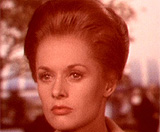
The Color Red - Triggering Fear

Flashback: Murdered Sailor

Young Marnie at Scene of Crime
|
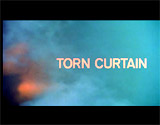
Torn Curtain (1966)
|
- the MacGuffin: the secret formula of mathematical
equations (known by East German scientist and Professor Gustav
Lindt (Ludwig Donath)) for an anti-nuclear device or anti-missile
defense rocket ("Gamma Five") that the East Germans had been
developing to compete with the American anti-missile program
- at Karl Marx University in Leipzig, Germany, Professor
Lindt (Ludwig Donath) was tricked and goaded by defecting US physicist
and rocket scientist Michael Armstrong (Paul Newman) - a double-agent
- into divulging his entire complicated equation on his classroom
blackboard; the scientist boasted:
"But it works! In Russia we built it, it works!"; Armstrong
congratulated him: "My God. That's brilliant. You jumped a step,
didn't you?";
the Professor bragged: "Of course it's brilliant. It's genius.
The Russians thought I was crazy. They didn't know I'm Lindt";
but then after realizing his mistake and that he had revealed everything
without learning anything himself, he mused: "You
told me nothing. You know nothing" - he ordered Armstrong: "I
forbid you to leave this room"
|

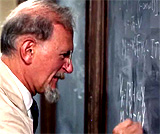
E. German Prof. Lindt Goaded Into Revealing Mathematical
Equations for Soviet Anti-Missile Defense System
|
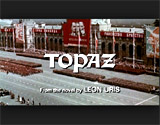
Topaz (1969)
|
- the MacGuffin: the identity of Topaz -- What
or who was Topaz? Who was in Topaz? What was its function?
- "Topaz" was ultimately revealed to be the
code-name for a group of elite intelligence agents in the
French government who were traitors; they were actually Soviet
spies or Communist moles leaking NATO documents to the Soviet KGB;
the documents in question were regarding the delivery and installation
of Soviet missiles bases and nuclear warheads to Cuba in the fall
of 1962 (the Cuban Missile Crisis)
- in the film, the informal group of French
traitors was exposed by a high-ranking Soviet intelligence and
KGB officer Boris Kusenov (Per-Axel Arosenius), who defected to
the West with the help of the US CIA, and
confirmed that four classified, top-secret NATO documents had been
leaked to him and other Soviets from French diplomats
- Jacques Granville (Michel Piccoli), code-named "Columbine," was
revealed to be the leader of the spy ring
- NATO official and economist
Henri Jarré (Philippe
Noiret) was his second-in-command
- another MacGuffin: visiting Castro-like Cuban
revolutionary Rico Parra's (John Vernon) locked red leather briefcase
in his makeshift office in a hotel in Harlem, NY, that held an alarming,
written "trade-pact"
agreement - with imminent plans for the Soviets to ship in and
presumably supply Cuba with "offensive weapons" (Russian
missiles with nuclear warheads); photos were secretly taken of
the documents by ex-French operative Philippe Dubois (Roscoe Lee
Browne), who ran the Martinique Flower Shop in Harlem, NY, and
was able to surreptitiously deliver his camera (with the photos)
to French intelligence Chief André Devereaux
(Frederick Stafford); Devereaux was working with the US' CIA Intelligence
Agent Michael "Mike"
Nordstrom (John Forsythe) in Washington, DC
- another MacGuffin-esque element in the film: the
microfilm (hidden in a slim volume of poetry) that revealed the
unloading of Soviet missiles at the dock in Cuba (documented in
pictures taken by underground members Carlotta and Pablo Mendoza);
the evidence was given to André Devereaux as a gift by his
undercover counter-revolutionary mistress Juanita (Karin Dor) before
he left Cuba
|
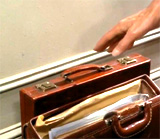
Rico Parra's Locked Red Leather
Briefcase
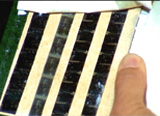
Strips of Microfilm Hidden in a Book of Poetry
Given to Andre Devereaux by his mistress-lover Juanita
|

Frenzy (1972)
|
- the MacGuffin: the necktie-killer Bob Rusk's (Barry
Foster) distinctive tie pin (with the initial R inset with diamonds)
- it had to be removed from his tie before he raped and strangled
his female victims
- the tie-pin was left behind at the scene of the
crime after the killing of Barbara "Babs" Milligan (Anna
Massey) - it was clenched in her corpse's hand
(her stiff body suffering from rigor mortis was stuffed
in a potato sack and loaded into the back of a truck-lorry); Rusk
was forced to jump into the back of the lorry and pry open her
hand to retrieve the tie-pin, as the vehicle moved along during
the night - a tense sequence
- in the conclusion, Rusk was found about to deposit
his latest female victim into a trunk for
disposal; he was pointedly asked by Chief Inspector Timothy Oxford
(Alec McCowen): "Mr.
Rusk, you're not wearing your tie"
|
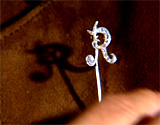
Rusk's Incriminating Initialed/Monogrammed Stickpin
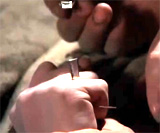
Removing the Tie-Pin From a Corpse's Hand
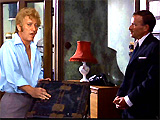
"Mr. Rusk, you're not wearing your tie!"
|

Family Plot (1976)
|
- the MacGuffins: (a) the search in California
for a missing heir - a nephew named Eddie Shoebridge, and
(b) the location of a ransomed, criminally-acquired diamond
exchanged for a kidnap victim
- during a seance session in the mid-1970s in the
elegant Victorian mansion of elderly matron-spinster Julia Rainbird
(Cathleen Nesbitt) conducted by fake spiritualist 'Madame' Blanche
Tyler (Barbara Harris), Julia confessed that her recently-deceased
sister Harriet Rainbird - as an unmarried mother - had borne an
illegitimate son 40 years earlier; Julia had facilitated the adoption
of the boy, who then disappeared and had become estranged from
the family; Julia feared that Harriet was angry with her for slighting
her deserving son and not offering her inheritance fortune to him
- Blanche was asked to investigate and locate the
whereabouts of Julia's nephew, after being paid $10,000
to locate her missing heir; she was paired up with self-professed
"actor" boyfriend George Lumley (Bruce Dern) and amateur
detective, who was forced to work to pay bills as a taxi-cab driver;
he bragged about how he deserved all the credit for his sleuthing and
investigative work for her
- another corresponding subplot told about a second
criminal couple: Arthur Adamson (William Devane) and his attractive
associate-girlfriend Fran (Karen Black); they were partnering together
to kidnap rich or wealthy persons in San Francisco, followed by
the demand for a ransom (of a valuable diamond);
Arthur taped, hid, and concealed their first diamond ransom
within the crystal chandelier near the staircase in his home, where
it supposedly wouldn't be noticed

|
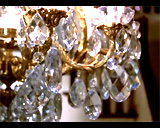
|

|
|
Diamond Hidden or Concealed in Arthur Adamson's
Crystal Chandelier (Revealed in a Zooming Closeup)
|
- Arthur (nicknamed "The Trader")
was eventually revealed to be a rich crook, who was also operating
a jewelry store in the city; in the film's major plot twist, he
was discovered to be Julia Rainbird's missing nephew (Eddie Shoebridge)
who had
contracted to have his adoptive parents (Harry and Sadie
Shoebridge) murdered, and had also faked his own death 25 years
earlier (Eddie's grave was discovered empty with a tombstone dated
1950)
- in the ending, the location of Arthur's first
stolen ransomed diamond was discovered by Blanche who faked a
trance - hanging from the crystal chandelier in his home near the
staircase; the film concluded with a smiling Blanche who sat on
the stairs, looked at the camera and winked at the audience (breaking
the fourth wall)
|
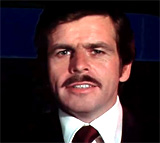
Arthur Adamson (William Devane) - A Jewel Thief and Kidnapper (His Real Name: Eddie Shoebridge, the
Missing Rainbird Heir)
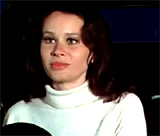
Fran (Karen Black) - A Brunette Partner in Crime with Arthur
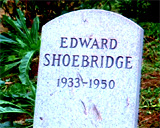
Barlow Creek Cemetery: Evidence of Edward's Faked Death,
With A Tombstone Erected Over an Empty Grave
|










































































